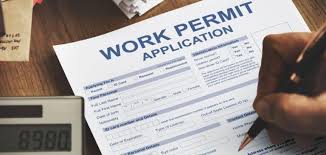How Long Does It Take to Get a United States Work Permit?
Securing a work permit, known officially as an Employment Authorization Document (EAD), is essential for many foreign nationals seeking employment in the United States.
The time it takes to obtain a work permit depends on various factors, including the type of visa or immigration status, the applicant’s location, and specific circumstances.
This article provides a detailed overview of the work permit process, the factors influencing processing time, and the general expectations for each category of applicants.
Understanding the U.S. Work Permit (EAD)
A U.S. work permit is a legal document issued by U.S. Citizenship and Immigration Services (USCIS) that allows foreign nationals to work legally in the country. An EAD is typically granted to those who are temporarily living in the U.S. based on their visa or pending immigration status. It is important to note that an EAD is not a visa but rather an authorization to work in the U.S. while residing in the country under a specific visa or immigration status.
The EAD is required for many non-citizens, including refugees, asylum seekers, students with specific visas (such as F-1 students with Optional Practical Training), family-based immigration applicants, and individuals with Temporary Protected Status (TPS). Obtaining this permit requires filing Form I-765, Application for Employment Authorization, with USCIS.
Typical Processing Time for a U.S. Work Permit
The processing time for a work permit varies depending on the individual’s situation and the specific type of visa or immigration status under which they are applying. On average, the processing time for a work permit ranges from 5 to 7 months from the date of filing the application. However, there are cases where the processing time may be shorter or significantly longer.
Several factors influence the processing time, such as:
- Current Workload of USCIS: Processing times can fluctuate depending on the workload at USCIS. If there is an influx of applications for work permits or other immigration benefits, processing times may be longer.
- Application Category: Different categories of applicants have different processing times. For example, applicants who are spouses of U.S. citizens or lawful permanent residents may experience different wait times compared to asylum seekers or individuals with TPS.
- Field Office Location: The processing time can also depend on the applicant’s geographic location. Certain USCIS service centers may experience higher volumes of applications, leading to delays in processing.
- Completeness of the Application: Missing or incorrect information can delay the processing of an EAD application. USCIS may issue a Request for Evidence (RFE) if the initial application is incomplete or contains errors, adding additional time to the process.
- Background Checks: All applicants for work permits are subject to background checks, which can extend the time it takes to process the application, particularly if there are complications in verifying the applicant’s identity or history.
Let’s delve into the various categories of applicants and their respective timelines for securing a U.S. work permit.
Work Permit Processing Times by Applicant Category
1. Family-Based Immigration Applicants
Individuals who are adjusting their immigration status through a family-based petition, such as the spouse or fiancé(e) of a U.S. citizen or permanent resident, can apply for a work permit concurrently with their application for adjustment of status. In such cases, Form I-765 is typically filed along with Form I-485 (Application to Register Permanent Residence or Adjust Status).
For family-based applicants, the work permit processing time generally ranges from 6 to 8 months. This timeline is often aligned with the processing of their adjustment of status application, allowing them to work while waiting for their green card to be approved.
2. Asylum Seekers
Asylum seekers are eligible to apply for a work permit if their asylum application has been pending for at least 150 days, and no decision has been made by USCIS or an immigration judge. The rule, known as the “150-day clock,” allows applicants to file Form I-765 after this waiting period, provided their application is still under review.
Once the 150-day threshold has been met, the processing time for the EAD typically takes 30 to 90 days. However, as of recent years, the process can extend beyond this window due to an increase in asylum applications and other backlogs.
3. Refugees and Asylees
Refugees and individuals who have been granted asylum are automatically eligible for employment authorization upon receiving their status. They may apply for a work permit either before or after entering the U.S. as a refugee, or immediately upon being granted asylum.
The processing time for refugees and asylees to receive a work permit is generally 4 to 6 months, depending on the volume of applications and USCIS processing capabilities.
4. Temporary Protected Status (TPS) Holders
Temporary Protected Status (TPS) is granted to individuals from specific countries designated by the U.S. government as unsafe for return due to conflict, environmental disaster, or other extraordinary conditions. TPS holders are eligible for work authorization while their status is valid.
For individuals with TPS, the work permit processing time is typically 6 to 8 months, though it can vary based on USCIS workload and the applicant’s specific situation.
5. Students (F-1 Visa Holders) on Optional Practical Training (OPT)
F-1 students are allowed to work under specific conditions through the Optional Practical Training (OPT) program. OPT allows F-1 visa holders to work in their field of study for a set period after completing their degree.
Students applying for an EAD under the OPT program typically wait between 2 to 5 months for processing. This timeline can vary based on the student’s specific situation and whether they are applying for pre-completion or post-completion OPT. It’s advisable for students to apply as early as possible (up to 90 days before their program end date) to avoid delays in employment.
6. H-4 Visa Holders (Spouses of H-1B Visa Holders)
Certain H-4 visa holders, who are the spouses of H-1B visa holders, may be eligible to apply for a work permit if the H-1B spouse has begun the process of seeking permanent residency (green card) or if their H-1B spouse has extended their status beyond the six-year limit.
For eligible H-4 visa holders, the work permit processing time is usually 6 to 8 months, though delays can occur due to USCIS workload or background checks.
7. Deferred Action for Childhood Arrivals (DACA) Recipients
DACA provides temporary protection from deportation for individuals who were brought to the U.S. as children and allows them to work legally in the country. DACA recipients are required to renew their status and work authorization every two years.
For DACA recipients applying for or renewing their work permit, the processing time generally ranges from 3 to 5 months, though it can vary depending on the applicant’s specific circumstances and USCIS backlogs.
Factors That Could Delay Work Permit Processing
While the typical processing times provide a general idea of how long it may take to receive a work permit, there are several factors that could delay the process:
- Increased Demand and Backlogs: Large volumes of applications, especially during times of immigration reform or new policy announcements, can lead to processing delays.
- Incomplete Applications: If an application is missing required documentation or contains errors, USCIS will issue a Request for Evidence (RFE), which can extend the timeline significantly. It’s crucial to ensure all required forms and supporting documents are complete and accurate.
- Background Check Delays: In some cases, background checks may take longer due to issues verifying the applicant’s identity or past history. Any criminal history, inconsistencies in documentation, or delays in retrieving records can prolong the process.
- Changes in Immigration Policy: Shifts in U.S. immigration policies can also affect processing times. For instance, new restrictions, expanded eligibility, or procedural changes can create bottlenecks in the system.
- Renewals and Expirations: Individuals who fail to apply for a renewal of their work permit in a timely manner could face gaps in employment authorization. Renewal applications should be filed at least 90 days before the expiration date of the current EAD to avoid delays.
Expedited Processing for Work Permits
In some cases, applicants may qualify for expedited processing of their work permit application. USCIS may expedite the processing if the applicant meets certain criteria, such as:
- Severe financial loss to the company or individual
- Emergency situations
- Humanitarian reasons
- Clear USCIS error in the handling of the case
However, expedited processing is granted only in exceptional circumstances, and applicants must provide substantial evidence to justify the request.
Conclusion
The timeline for receiving a U.S. work permit varies depending on the applicant’s visa type, status, location, and the workload at USCIS. On average, applicants can expect to wait between 5 to 7 months for their work permit, but certain categories, such as asylum seekers and students on OPT, may have shorter or longer timelines.
Applicants must be diligent in submitting complete applications with all necessary documentation to avoid delays. While processing times can fluctuate due to various factors, understanding the process and planning accordingly can help reduce the uncertainty and stress associated with obtaining a work permit in the United States.






